I will hopefully move some of this content to my old moldy Shoal Creek Debacle Page when I get time.
Brief introduction: Prior to around 2000, Shoal Creek Boulevard was a minor arterial roadway with extensive bicycle traffic in fairly wide bike lanes which allowed parking (which presented a problem, since modern engineering practice does not allow parking in bike lanes). Shoal Creek’s turn came in the “put up no-parking signs in bike lanes” carousel, and the city came up with a plan to preserve on-street parking on one side of the street. The neighbors freaked; a consultant came up with a ridiculous cyclist-killer proposal; the city rejected it; and then a small group of neighborhood people came up with the idea to just stripe a wide “shared lane” for parked cars, cyclists, and pedestrians. With curb extensions to theoretically slow traffic, although since the extensions don’t go out to the travel lane (so cyclists can pass), their effect is likely to be minimal.
Here’s some stuff that’s been happening recently:
- The neighborhoods’ email groups (allandale and rosedale) have been full of complaints about the curb extensions, as well as observations about bad driver behavior, including running over and up onto curb extensions. Additionally, neighbors have complained that the bike lane stripe (separating the bike lane from the parking lane) never got put in, which shows that some people didn’t realize that the awful Gandy plan was shelved when no engineers would sign on to it. Finally, motorists have (as I predicted) been using the shoulder as a driving or passing lane.
Gandy’s plan, endorsed by the neighborhood:
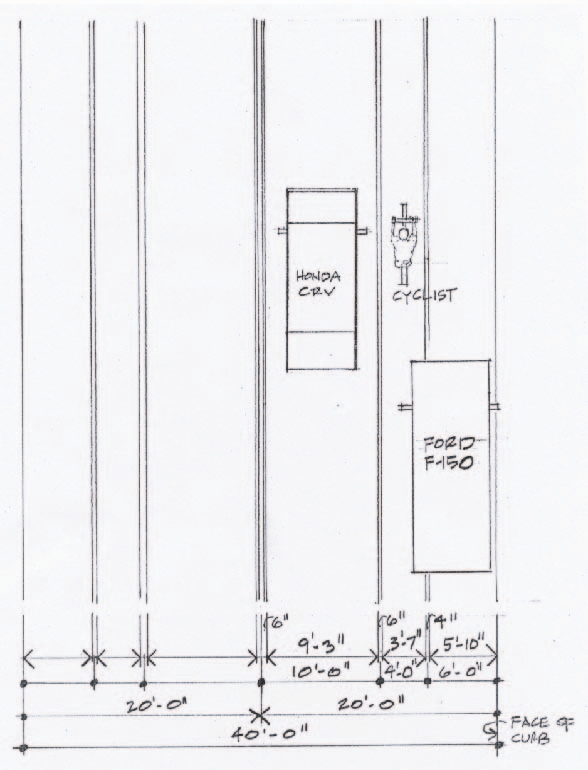
The current striping is basically the image above, with no stripe separating the bike lane and parking lane. - Neighbors still think there’s a “bike lane” here. There isn’t. There’s a shoulder, with insufficient space in which to safely pass parked cars. (the absence of the stripe separating the 10 feet into 4 and 6 a la the Gandy plan doesn’t change the geometry here – bicyclists must still enter the travel lane in order to safely pass a parked vehicle).
Images copied from Michael Bluejay:
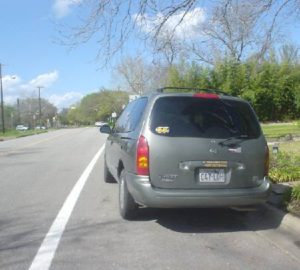
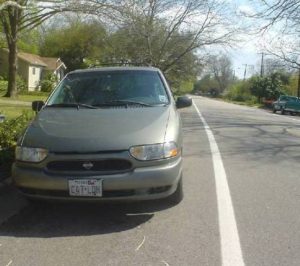
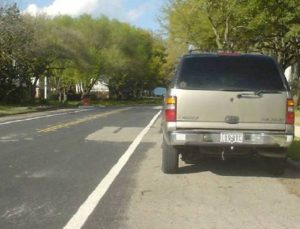
- Motorists are still expecting cyclists to stay in the bike lane. I rode home down Shoal Creek on Monday, and had some indications of impatient motorists behind me as I passed parked cars (no honking this time at least). Remember that even when there’s a bit more room than in the pictures above, you still have to worry about the dooring problem. Even the city compromise with parking on one side had this problem (although to a far lesser degree).
- Parked car and passing car conflicts continue to be high. Many people who supported this debacle from the beginning are still cowering behind the idea that since parked cars are “scarce” (average of ten on each side for the entire stretch from Foster to 38th), that we don’t need to worry about the passing conflicts. The problem, however, is that due to the higher speeds of automobiles, there is a very high chance of conflict on each one of those passes, meaning that it is very likely that a motorist will slow down and wait behind a passing cyclist on each pass. In fact, on Monday, my experience was that 4 out of the 5 times I performed this passing manuever, there were motorists stuck behind me by the time I went back into the shoulder area; and the fifth time I found myself stuck while a car passed me (I didn’t get out into the lane early enough).
- People continue to misrepresent this process as a compromise (implying that cyclists got something, parking motorists got something, drivers got something, neighborhood got something, etc). In fact, any rational observer can compare conditions before this change to conditions now and make the following judgement: Parking won. Period. Cyclists got less than they had before, and far less than they should have had. The neighborhood got curb extensions (even though they won’t work). Cyclists got the middle finger.
- The City Council member most responsible for this debacle, Jackie Goodman, is being term-limited out of office. Unfortunately, I hold little hope that a stronger (i.e. decision-maker rather than consensus-hoper) member will emerge from the pack seeking election.
- Neighborhood troublemakers are still misrepresenting the history of this debacle; failing to mention that the original proposal from the city for this roadway preserved on-street parking on one side of the road, which is more than almost any minor arterial roadway (SCB’s original classification) has, and about average for collectors (SCB’s new neighborhood-forced underclassification). This city proposal represented a substantial compromise of bicycle interests, but because it didn’t preserve ALL on-street parking, several malcontent nincompoops in the neighborhood fought it bitterly.
- The same neighborhood troublemakers continue to misrepresent Shoal Creek’s role in the city’s transportation system. SCB was originally (correctly) classified as a minor arterial, which means that its main purpose is not for property access, but for a combination of traffic collection/distribution and small amounts of through traffic. For cyclists, SCB is a critical transportation link, since it’s so long, and has right-of-way at all intersections (meaning it never has a 2-way stop where through traffic doesn’t stop; everything’s either a 4-way stop or traffic light). SCB was reclassified thanks to neighborhood pressure to a “residential collector” around 2001ish, against my objections (I-TOLD-YOU-SO-MARKER: I told the other members of the UTC at the time that this change would make it easier for them to then prevent no-parking-in-bike-lanes). Also note that this makes SCB, by far, the longest collector roadway in the city. The neighborhood, ever since then, has claimed that SCB is a “residential street”, which means something very different from “residential collector”. A “residential street” is supposed to serve property access first, parking second, and distribution a distant third, with essentially no provision for through traffic. A “residential collector”, on the other hand, is supposed to serve distribution first, property access second, through traffic third, and parking last.
The original city plan, preserving on-street parking on one side:
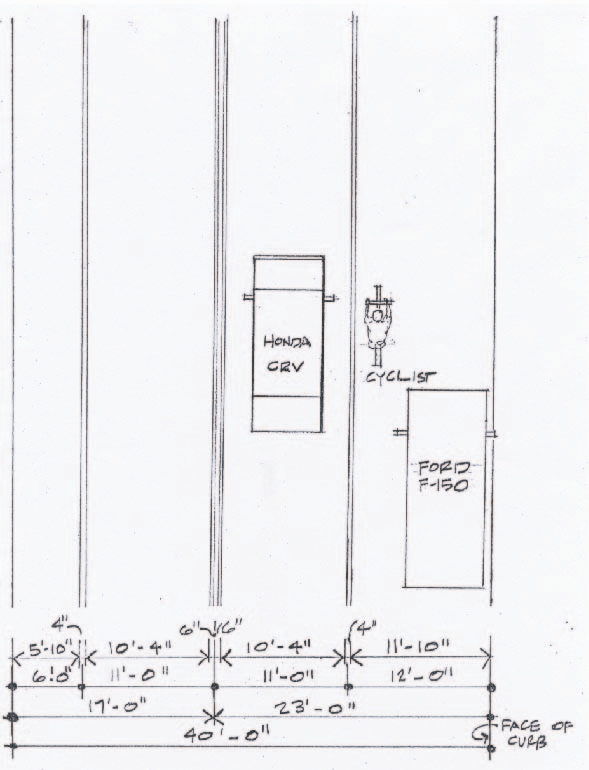
- (Humor value only): One of the malcontent neighborhood nincompoops has surfaced again on my old fan group (from my undergraduate days; no, I didn’t make it).
Mike–To follow up on our e-mail discussion, my wife came up with a possible justification for those curb islands: to prevent motorists from driving in the parking lane. I suspect that this is a post-hoc justification, but it makes some sense (though it suggests more foresight than the rest of the project if it is not post-hoc).
In fact, I believe that your wife’s probably correct, but the curb islands were sold publically as a traffic-calming measure. (The cyclists who got duped by the neighborhood honestly believed, I think, that traffic calming would make things better for cyclists, making this whole thing worthwhile – forgetting that a 10 mph reduction in speed doesn’t necessarily result in fewer collisions).
There were posted on SCB today a bunch of signs advertising a City of Austin public hearing on the curb islands at Gullet Elementary cafeteria, Weds., April 11, 7 PM. These things are awful, presenting hazards to both cyclists and car drivers. AND, I here that their aggregate cost was over $300000 dollars – where else would this money have been better spent?